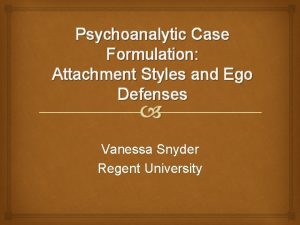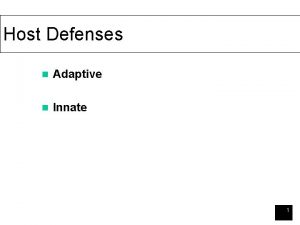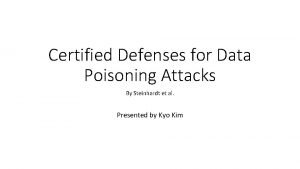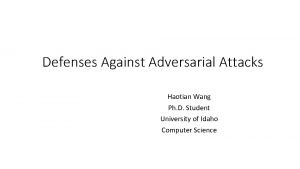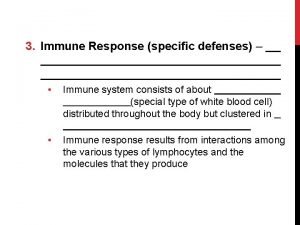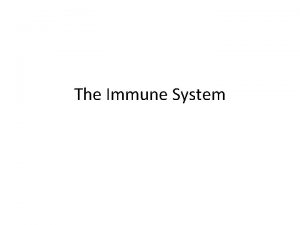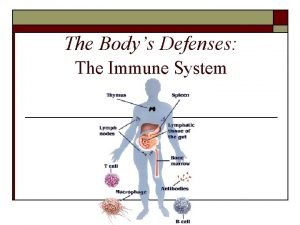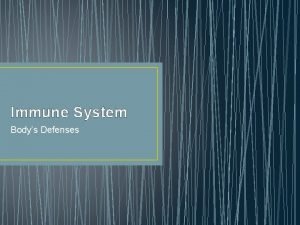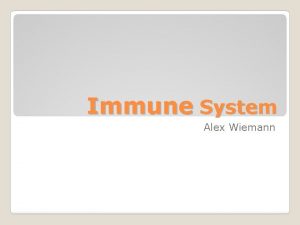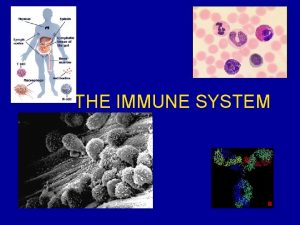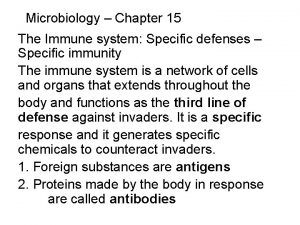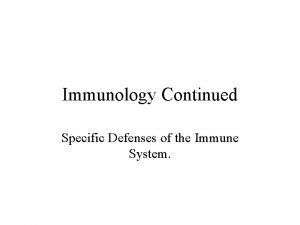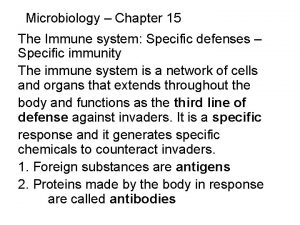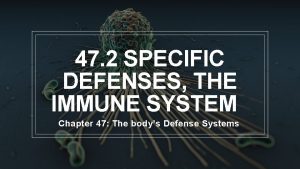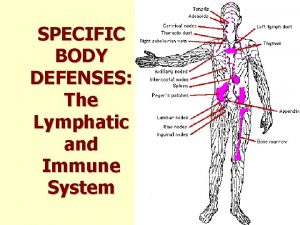NOTES IMMUNE SYSTEM SPECIFIC DEFENSES Specific Defenses immune












- Slides: 12

NOTES – IMMUNE SYSTEM – SPECIFIC DEFENSES • Specific Defenses • immune system attacks a specific disease causing agent • ANTIGENS • something that triggers an immune response

• KEY CELLS • Lymphocyte • a type of wbc (white blood cell)

• B - lymphocyte • produces ANTIBODIES – attach to antigen to destroy bacteria • Antibodies • basic unit of the immune system • shaped like the letter “Y”

Specific Immune Response I. Cell Mediated Immunity • T – cells that directly attack antigens • KILLER T – CELLS cause pathogens to rupture & die • responsible for transplant rejection, destroying certain cancer cells, fungal infections

II. Humoral Immunity • PLASMA CELLS (specialized b – cells) release antibodies into the bloodstream when a pathogen enters the body • this process is aided by T – lymphocytes (T – cells) – wbc’s from thymus gland • T – cells help regulate production of antibodies by b – cells • Antibody Production • b – lymphocytes produce one cell that can rearrange its genetic code • this allows for many different types of antibodies

• can bind to two antigens at once – causes virus to AGGLUTINATE or clump together • phagocyte can then destroy the agglutinated virus • antibodies will do the same thing to bacteria

• Immunity • after exposure to certain diseases, the body does not become infected with those diseases again • EX: chicken pox • b – cells & T – cells remain capable of producing the same antibodies for life • this is called the SECONDARY IMMUNE RESPONSE • very quick – disease never gets a chance to develop

I. Active Immunity • injection of an ATTENUATED or weakened form of a virus or bacteria • Ex: Jenner & smallpox • allows body to produce immunity without contracting the disease first

II. Passive Immunity -- antibodies from another person or artificially produced introduced to protect another person Ex. Mother’s antibodies passed on to newborn

NOTES – IMMUNE SYSTEM DISORDERS • Allergies • results from an “overreaction” of the immune system • immune system produces chemicals called HISTAMINES – cause sneezing, runny nose, etc. • EX: food allergies, bee stings, penicillin, etc • can produce serious allergic reactions • Anaphylactic Shock • massive release of histamine – bronchioles contract – no air into or out of lungs

• Autoimmune Diseases • occurs when immune system attacks body’s own cells • can be the result of infection – Ex: Rheumatic Fever attacks heart as a result of strep throat • other ex: rheumatoid arthritis, juvenile diabetes, multiple sclerosis

• AIDS • What does AIDS stand for? • Acquired Immune Deficiency Syndrome • HIV • Human Immunodeficiency Virus – causes AIDS • retrovirus – genetic info is contained in RNA • begins in Helper T – cells, virus not affected by the immune system • virus makes it impossible for body to respond to disease • virus continually mutates – makes vaccine, medication difficult
 A subsequent
A subsequent Chapter 12 the lymphatic system and body defenses
Chapter 12 the lymphatic system and body defenses Quizlet
Quizlet Chapter 12 the lymphatic system and body defenses
Chapter 12 the lymphatic system and body defenses Primitive coping mechanism
Primitive coping mechanism Host defenses
Host defenses On adaptive attacks to adversarial example defenses
On adaptive attacks to adversarial example defenses Certified defenses for data poisoning attacks
Certified defenses for data poisoning attacks Nicolas papernot
Nicolas papernot What is the third line of defense in the immune system
What is the third line of defense in the immune system Flow chart
Flow chart Third line of defense immune system
Third line of defense immune system Innate immunity first line of defense
Innate immunity first line of defense




